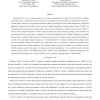Free Online Productivity Tools
i2Speak
i2Symbol
i2OCR
iTex2Img
iWeb2Print
iWeb2Shot
i2Type
iPdf2Split
iPdf2Merge
i2Bopomofo
i2Arabic
i2Style
i2Image
i2PDF
iLatex2Rtf
Sci2ools
ANSS
2007
IEEE
2007
IEEE
Vehicular Mobility Simulation for VANETs
During the last few years, continuous progresses in wireless communications have opened new research fields in computer networking, aimed at extending data networks connectivity to environments where wired solutions are impracticable. Among these, vehicular traffic is attracting a growing attention from both academia and industry, due to the amount and importance of the related applications, ranging from road safety to traffic control, up to mobile entertainment. Vehicular Ad-hoc Networks (VANETs) are self-organized networks built up from moving vehicles, and are part of the broader class of Mobile Ad-hoc Networks (MANETs). Because of their peculiar characteristics, VANETs require the definition of specific networking techniques, whose feasibility and performance are usually tested by means of simulation. One of the main challenges posed by VANETs simulations is the faithful characterization of vehicular mobility at both macroscopic and microscopic levels, leading to realistic no...
| Added | 02 Jun 2010 |
| Updated | 02 Jun 2010 |
| Type | Conference |
| Year | 2007 |
| Where | ANSS |
| Authors | Marco Fiore, Jérôme Härri, Fethi Filali, Christian Bonnet |
Comments (0)

